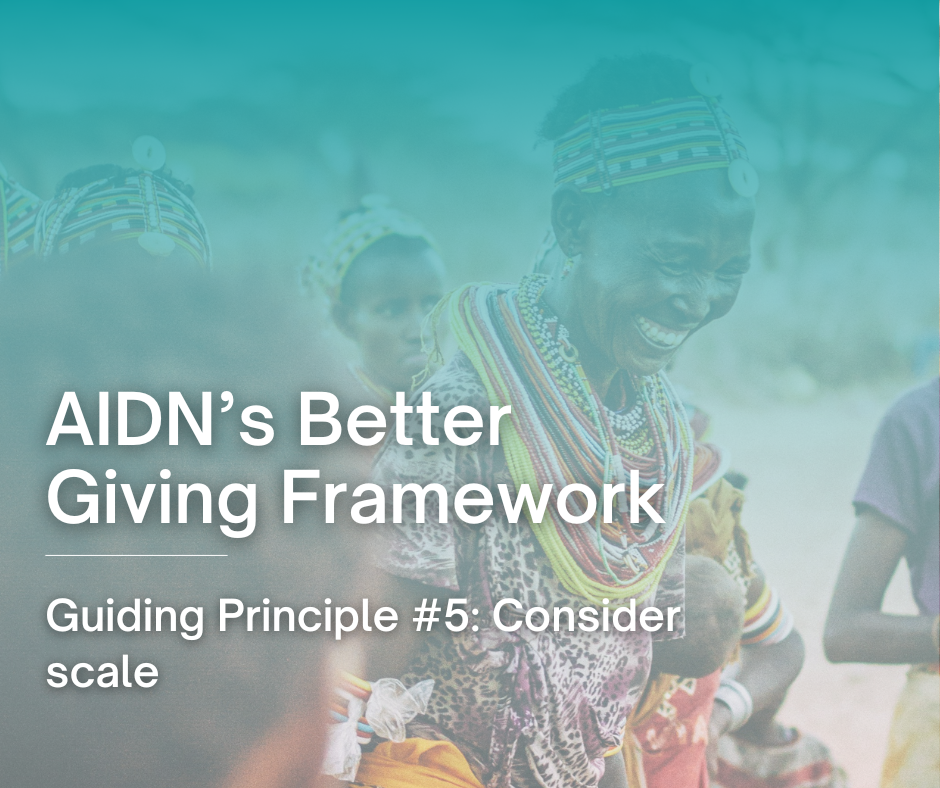AIDN’s Better Giving Framework is a key resource for funders that shares what we believe, and what our network has helped us to understand, are the key principles that underpin “better” giving and investing in today’s international development sector. The fifth Guiding Principle of our Better Giving Framework is: “Consider scale”. Read below to learn more about and access detailed resources on Guiding Principle #5.
Before giving to or investing in international development programs, AIDN also recommends that funders consider scale or the scalability of a program. Due to the urgency of today’s issues including poverty, hunger, education and climate change, many funders argue that we must priortise investing in scalable solutions.
A scalable solution is one that has the potential to make a big dent in a big social problem or maybe even solve it in its entirety. Take the example of Wawira Nijuru’s Food4Education. In Kenya, more than 23 million Kenyan children go to school hungry each day. In 2012, 32 year old Wawira Njiru founded Food4Education and from inception, funders were encouraged to think about the long-term and scalable potential of the organisation. Today, Food4Education supplies meals to 500,000 school children a day and has scaled up to government adoption with Nairobi County.
As will be discussed in Guiding Principle #6, scalable solutions do not create parrallel systems, but instead work with, embed within or build the capacity of the existing systems. They also often foster cross-sector collaboration. A further example to demonstrate this process is Community Health Impact Coalition’s commitment to the mobilisation and professionalisation of Community Health Workers globally. In order to address the enormous access gaps to public health in low-income communities, CHIC seeks to economically empower health workers that are already effectively and appropriately embedded within local systems.
However, it is also important to note that “considering scale” does not only mean looking for programs that can be scaled up. Instead, and as Kevin L Brown explained in his AIDN Philanthropod episode, funders should be aware that not every organisation should or needs to scale. Instead, some organisations create their greatest impact at a certain size. This is often because their programs are nuanced, culturally situated and created to address very specific problems in appropriate ways. For example, a culturally specific center for women who have experienced Gender Based Violence (GBV) in Timor-Leste may not be scalable or transferable to other communities, regions or countries. Nevertheless, this does not diminish the impact of these programs, and instead simply speaks to importance of immediate needs provision and localised models.
For more resources on scaling in international development:
- “Scaling up: What it means and why it matters“ by Imago Global Grassroots 2022.
- “Big Enough. Simple Enough. Cheap Enough” by Kevin Starr for The Stanford Social Innovation Review 2019.
- “Reimagining scaling: Reflections, principles, and perspectives on scaling locally-led humanitarian innovations” by Start Network 2025.
- “The business of bold philanthropy” – AIDN’s Philanthropod 2025 with Dave and Kerry Rickards, Founders of DAK Foundation and the DAK International Network.
- “Unlocking growth: Branding, storytelling and the future of fundraising” – AIDN’s Philanthropod 2025 with Kevin L Brown, CEO of Mighty Ally.
- “Education for every girl: How community and data driven approaches are changing the game in India” by Nooreen Dossa for The AIDN Beat 2025.
- “The next opportunity for Australian aid and development? Scalable investments in African education” by Cassandra Treadwell for The AIDN Beat 2024.
- “Stop buying sunshine: The 10% stake every donor should take to ending stunting in Indonesia” by Zack Peterson for The AIDN Beat 2025.
